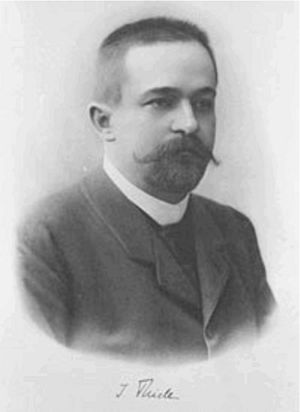Johannes Thiele (chemist) facts for kids
Quick facts for kids
Friedrich Karl Johannes Thiele
|
|
|---|---|
 |
|
| Born | May 13, 1865 |
| Died | April 17, 1918 (aged 52) |
| Nationality | German |
| Alma mater | University of Halle |
| Known for | Thiele tube |
| Scientific career | |
| Fields | Chemistry |
| Institutions | University of Munich, University of Straßburg |
| Doctoral advisor | Jacob Volhard |
| Doctoral students | Heinrich Otto Wieland, Jakob Meisenheimer, Hermann Staudinger, Otto Dimroth, Sir Robert H. Pickard |
Friedrich Karl Johannes Thiele (born May 13, 1865 – died April 17, 1918) was an important German chemist. He was a well-known professor at several universities. These included the University of Munich and the University of Strasbourg.
Thiele created many lab methods. These helped to separate different organic compounds. In 1907, he invented a special device. It was used to find the exact melting point of substances. This device is now called the Thiele tube after him.
Contents
Early Life and Education
Johannes Thiele was born in Ratibor, Prussia. This place is now called Racibórz in Poland. He first studied mathematics at the University of Breslau. Later, he changed his focus to chemistry. He earned his advanced degree, called a doctorate, from the University of Halle in 1890.
Teaching and Research
Thiele taught at the University of Munich from 1893 to 1902. After that, he became a chemistry professor at Strasbourg. He was known for his work in organic chemistry.
Developing New Chemical Compounds
Thiele developed a way to make a substance called glyoxal bis(guanylhydrazone). He also found a new method to create fulvenes. These are special chemical compounds. He made them by combining ketones and aldehydes with cyclopentadiene. Fulvenes are known for their deep colors. He also noticed that fulvenes were similar to, but different from, benzene compounds.
Understanding Chemical Bonds
After Kekulé suggested a structure for benzene in 1865, Thiele had his own idea. He proposed a "Partial Valence Hypothesis." This idea helped explain why double and triple carbon-carbon bonds react in a special way.
In 1899, his work led to predicting resonance in benzene. Resonance means that electrons in a molecule are shared in a way that can be shown by more than one structure. Thiele drew a special structure for benzene. He used a broken circle to show these shared, or "partial," bonds. Later, quantum theory fully explained this idea.
Leading Organic Chemistry
In 1899, Thiele became the head of Organic Chemistry. This was at the Bavarian Academy of Sciences and Humanities in Munich. With his helper, Otto Holzinger, he created a new chemical structure. It was called an iminodibenzyl nucleus. This structure had two benzene rings connected by a nitrogen atom and an ethylene bridge.
Personal Views
One of Thiele's students, Heinrich Otto Wieland, said something interesting about him. Thiele reportedly did not like studying the chemistry of natural products.
See also
 In Spanish: Johannes Thiele (químico) para niños
In Spanish: Johannes Thiele (químico) para niños

